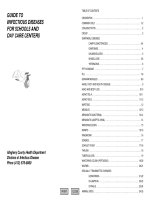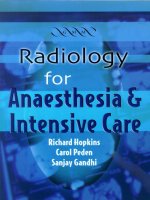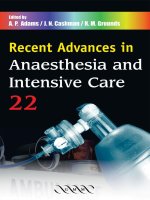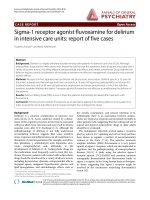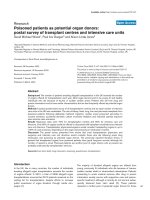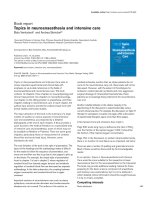radiology for anaesthesia and intensive care
Bạn đang xem bản rút gọn của tài liệu. Xem và tải ngay bản đầy đủ của tài liệu tại đây (7.41 MB, 353 trang )
Radiology for Anaesthesia and Intensive Care
Prelims.qxd 10/15/02 6:05 PM Page i
This page intentionally left blank
Radiology for Anaesthesia
and Intensive Care
Richard Hopkins
Consultant Radiologist
Department of Radiology
Cheltenham General Hospital
Carol Peden
Consultant Anaesthetist
Royal Bath United Hospital
Sanjay Gandhi
Department of Clinical Radiology
Bristol Royal Infirmary
LONDON SAN FRANCISCO
Prelims.qxd 10/15/02 6:05 PM Page iii
Greenwich Medical Media
4th Floor, 137 Euston Road,
London
NW1 2AA
© 2003
870 Market Street, Ste 720
San Francisco
CA 94109, USA
ISBN 184110 1192
First published 2003
Apart from any fair dealing for the purposes of research or private study,
or criticism or review, as permitted under the UK Copyright Designs and
Patents Act 1988, this publication may not be reproduced, stored, or transmitted,
in any form or by any means, without the prior permission in writing of the
publishers, or in the case of reprographic reproduction only in accordance with
the terms of the licences issued by the appropriate Reproduction Rights
Organisations outside the UK. Enquiries concerning reproduction outside
the terms stated here should be sent to the publishers
at the London address printed above.
The rights of Richard Hopkins, Carol Peden and Sanjay Gandhi to be identified
as authors of this work have been asserted by them in accordance with the
Copyright Designs and Patents Act 1988.
The publisher makes no representation, express or implied, with regard to the
accuracy of the information contained in this book and cannot accept any legal
responsibility or liability for any errors or omissions that may be made.
A catalogue record for this book is available from the British Library.
www.greenwich-medical.co.uk
Distributed worldwide by Plymbridge Distributors Ltd and
in the USA by Jamco Distribution
Typeset by Charon Tec Pvt. Ltd, Chennai, India
Printed by The Alden Group Ltd, Oxford
Prelims.qxd 10/15/02 6:05 PM Page iv
Contents
Acknowledgements . . . . . . . . . . . . . . . . . . . . . . . . . . . . . . . . . . . . . . . . . . . vii
Contributors . . . . . . . . . . . . . . . . . . . . . . . . . . . . . . . . . . . . . . . . . . . . . . . . . . ix
Introduction . . . . . . . . . . . . . . . . . . . . . . . . . . . . . . . . . . . . . . . . . . . . . . . . . . xi
About the FRCA examination . . . . . . . . . . . . . . . . . . . . . . . . . . . . . . . . . . . xiii
James K. Ralph, Carol J. Peden
The Primary examination . . . . . . . . . . . . . . . . . . . . . . . . . . . . . . . . . . . . xiii
The Final examination . . . . . . . . . . . . . . . . . . . . . . . . . . . . . . . . . . . . . . xiii
Preparation . . . . . . . . . . . . . . . . . . . . . . . . . . . . . . . . . . . . . . . . . . . . . . . xiv
Competency-based training and assessment . . . . . . . . . . . . . . . . . . . . xiv
The pre-operative assessment . . . . . . . . . . . . . . . . . . . . . . . . . . . . . . . . . . xvii
James K. Ralph
Looking at X-ray films as part of the pre-operative assessment . . . . xvii
Association of Anaesthetists of Great Britain and Ireland . . . . . . . . . xvii
Royal College of Radiologists . . . . . . . . . . . . . . . . . . . . . . . . . . . . . . . xviii
Task Force on Preanaesthetic Evaluation of the
American Society of Anaesthesiologists . . . . . . . . . . . . . . . . . . . . . xviii
1 Imaging the chest . . . . . . . . . . . . . . . . . . . . . . . . . . . . . . . . . . . . . . . . . . . 1
How to read a chest X-ray . . . . . . . . . . . . . . . . . . . . . . . . . . . . . . . . . . . . 2
The ‘normal’ chest X-ray in examination vivas . . . . . . . . . . . . . . . . . . . . 7
Case illustrations: plain films and CT . . . . . . . . . . . . . . . . . . . . . . . . . . . . 8
2 Imaging the abdomen . . . . . . . . . . . . . . . . . . . . . . . . . . . . . . . . . . . . . . 77
Plain abdominal films . . . . . . . . . . . . . . . . . . . . . . . . . . . . . . . . . . . . . . . 78
Case illustrations: plain films and CT . . . . . . . . . . . . . . . . . . . . . . . . . . . 80
3 Trauma radiology . . . . . . . . . . . . . . . . . . . . . . . . . . . . . . . . . . . . . . . . . 125
Chest trauma: case illustrations . . . . . . . . . . . . . . . . . . . . . . . . . . . . . . 126
Blunt abdominal and pelvic trauma: case illustrations . . . . . . . . . . . . 137
v
Prelims.qxd 10/15/02 6:05 PM Page v
4 The cervical spine . . . . . . . . . . . . . . . . . . . . . . . . . . . . . . . . . . . . . . . . . 163
Savvas Nicolaou, Richard Gee, Lai Peng Chan,
Cieran Keogh, Peter Munk
Introduction: clearing the cervical spine . . . . . . . . . . . . . . . . . . . . . . . 164
Non-traumatic conditions affecting the cervical spine . . . . . . . . . . . . 179
Trauma of the cervical spine . . . . . . . . . . . . . . . . . . . . . . . . . . . . . . . . . 195
5 CT head . . . . . . . . . . . . . . . . . . . . . . . . . . . . . . . . . . . . . . . . . . . . . . . . . 215
Principles of CT image formation . . . . . . . . . . . . . . . . . . . . . . . . . . . . . 216
Principles of interpreting CT . . . . . . . . . . . . . . . . . . . . . . . . . . . . . . . . . 219
Case illustrations . . . . . . . . . . . . . . . . . . . . . . . . . . . . . . . . . . . . . . . . . . 220
6 Anaesthesia in the radiology department with particular
reference to MRI and interventional radiology . . . . . . . . . . . . . . . . . 257
Anaesthesia in the Radiology Department . . . . . . . . . . . . . . . . . . . . . 258
Carol J. Peden
MRI: principles of image formation . . . . . . . . . . . . . . . . . . . . . . . . . . . 261
N. Matcham
MRI: anaesthetic monitoring . . . . . . . . . . . . . . . . . . . . . . . . . . . . . . . . 265
James K. Ralph and Carol J. Peden
MRI: case illustrations . . . . . . . . . . . . . . . . . . . . . . . . . . . . . . . . . . . . . . 270
N. Matcham
Interventional procedures: case illustrations . . . . . . . . . . . . . . . . . . . . 282
7 Ultrasound and intensive care . . . . . . . . . . . . . . . . . . . . . . . . . . . . . . . 301
Ultrasound imaging: principles of image formation . . . . . . . . . . . . . 302
Applications of ultrasound for patients on intensive care units . . . . 304
Ultrasound imaging: case illustrations . . . . . . . . . . . . . . . . . . . . . . . . . 312
Index . . . . . . . . . . . . . . . . . . . . . . . . . . . . . . . . . . . . . . . . . . . . . . . . . . . . . . 321
Contents
vi
Prelims.qxd 10/15/02 6:05 PM Page vi
Acknowledgements
Contributions to the book have been made by Dr I. Taylor, Dr C. Cook,
Dr C. Styles, Dr D. Fox and Dr R. Lowe.
All images contributed by Dr R. Hopkins and Dr S. Gandhi unless
otherwise stated.
Further images contributed by
Chapter 1
Mr L. Marchenco (Figs 1.1–1.4)
Dr M. Thornton (Fig. 1.48)
Dr M. O’Driscoll (Fig 1.53)
Dr M. Darby (Figs 1.55, 1.78, 1.83)
Dr J. Hawarth (Figs 1.80–1.82, 1.84–1.86)
Chapter 2
Dr A. Chalmers and Bath Royal United Hospital Film Museum
(Figs 2.11, 2.14, 2.15, 2.18, 2.19, 2.28)
Mr R. Law (Figs 2.24–2.27)
Dr N. Slack (Figs 2.33–2.35)
Dr M. Gibson (Fig. 2.36)
Chapter 4
Dr D. Graeb, Dr N. Müller (Figs 4.23, 4.24)
Vancouver General Hospital Department of Radiology
Chapter 6
Dr M. O’Driscoll (Fig. 6.14)
vii
Prelims.qxd 10/15/02 6:05 PM Page vii
This page intentionally left blank
Contributors
Lai Peng Chan
Vancouver General Hospital
British Columbia
Canada
Richard Gee
Vancouver General Hospital
British Columbia
Canada
Cieran Keogh
Vancouver General Hospital
British Columbia
Canada
Nicola Matcham
Specialist Registrar in Radiology
Bristol Royal Infirmary
Bristol, UK
Peter Munk
Vancouver General Hospital
British Columbia
Canada
Savvas Nicolaou
Vancouver General Hospital
British Columbia
Canada
James K. Ralph
Specialist Registrar in Anaesthesia
University Department of Anaesthesia
The Queen Elizabeth Hospital
Birmingham, UK
ix
Prelims.qxd 10/15/02 6:05 PM Page ix
This page intentionally left blank
Introduction
This book has been written for anaesthetists and intensive care doctors
working in hospital practice. The material in the book covers all the
common pathologies encountered in hospital anaesthetic practice and
intensive care. Included are the core radiological requirements for
the FRCA examination, but it is also ideally suited for doctors preparing
for the Diploma in Intensive Care Medicine. It is not only intended as an
examination revision aid, but also as a general radiological or revision text
in anaesthetic radiology. In addition to the more commonly encountered
areas such as chest and abdominal imaging, particular attention has been
given to the topics of cervical spine imaging and blunt trauma. Sections
covering trauma imaging of the chest, abdomen, pelvis, cervical-spine and
head are included.
An excellent knowledge of anatomy is crucial when interpreting
any radiological investigation. Particular attention has been paid to
illustrating relevant radiological anatomy. For each body system (chest and
cardiovascular, abdomen and pelvis, and head), the radiological anatomy
of both conventional radiographs and CT is discussed in some detail.
This appears at the beginning of the relevant chapters. For instance
Chapter 1, Imaging the chest, includes detailed diagrams of the cardiac
silhouette, the mediastinal outline and the anatomy which appears on a
conventional chest radiograph. In addition, the anatomy visible on chest CT
is explained and illustrated. Technology in radiology is advancing rapidly
especially in the fields of cross-sectional imaging such as CT and MRI.
Clinicians require a basic understanding of how various imaging modalities
work in order to be able to interpret the images correctly. The basic
principles of image formation in CT, MRI and ultrasound are explained.
These imaging modalities are of particular relevance to anaesthetists as
they frequently accompany sick patients to radiology departments for
clinical imaging studies. Special attention is paid to the unique problems
encountered in MRI scanners with particular regard to patient monitoring
and support systems.
In radiology, a diagnosis is often made by recognising patterns of
disease. Various imaging patterns such as air space shadowing, interstitial
lung patterns, solitary or multiple pulmonary nodules, etc. often have
xi
Prelims.qxd 10/15/02 6:05 PM Page xi
a broad differential diagnosis. Final diagnosis is dependent upon clinical
history, imaging features and further laboratory investigations. The clinical
case scenarios in the book have been written to include clinical history,
results of investigations and the radiology. For each case, a differential
diagnosis is given where appropriate and anaesthetic management is
discussed.
To derive the maximum benefit from each chapter, it is recommended
that the introduction to the main chapters is read prior to attempting
the accompanying clinical cases.
Introduction
xii
Prelims.qxd 10/15/02 6:05 PM Page xii
About the FRCA examination
James K. Ralph, Carol J. Peden
The Diploma of Fellow of the Royal College of Anaesthetists is a
two-part examination. These two parts are known as the Primary and Final
examinations. Each part comprises both written and viva examinations,
with the Primary also including an ‘OSCE’ (Objective Structured Clinical
Examination).
The Primary examination
The Primary examination is designed to assess trainees who have
completed 12 months of recognised training, although most will have
completed 18 months, before attempting the examination. The Primary
examination examines both the relevant basic sciences and clinical
practice of anaesthesia undertaken in the 12–18 months of training.
Candidates are expected to demonstrate a good understanding of the
fundamentals of clinical anaesthesia practice. With particular reference
to radiology, this includes the selection and interpretation of relevant
pre-operative investigations. Radiological images that may be encountered
will appear in the OSCE section of the examination. Interpretation will
take the form of short questions based on chest radiographs, neck and
thoracic inlet films, abdominal fluid levels/air/masses, skull films and other
imaging investigations (simple data only). The clinical viva in the Primary
examination does not include X-ray interpretation.
The Final examination
The Final examination is designed to assess trainees who have passed
the Primary examination and completed a minimum of 30 months of
recognised training. Final examination candidates are expected to have a
thorough knowledge of medicine and surgery, appropriate to the practice
of anaesthesia, intensive care and pain management. This includes
pre-operative assessment and selection and interpretation of appropriate
investigations. It also includes knowledge of diagnostic imaging and
xiii
Prelims.qxd 10/15/02 6:05 PM Page xiii
the appropriate anaesthesia and sedation, preanaesthetic preparation
and techniques appropriate for adults and children for CT scan, MRI and
angiography and post-investigation care. An understanding of the
principles of imaging techniques including CT, MRI and ultrasound is also
required.
The Final examination is also divided into four parts: MCQ, SAQ and
two vivas. There are two structured vivas: Viva 1 (50 minutes) – Clinical
Anaesthesia – is where radiological images will occur. This viva consists of a
long case and three short cases. During the first 10 minutes, you will have
the opportunity to view on your own clinical information related to the
long case, including radiological images (usually a chest X-ray). There are
easy marks to be had if you have practised X-ray interpretation.
An ordered, sensible approach to the chest X-ray will also give the
examiners the impression that you are safe and experienced – practise and
impress them! During the final 20 minutes you will be asked questions on
three further clinical topics.
Preparation
Preparation for the examination should start by obtaining and reading the
current syllabus and the examination regulations, which can be obtained
from the College. A period of intensive study is a prerequisite to success but
also realistic viva practice from consultant colleagues and recent successful
examination candidates. It is important to develop a system for reviewing
and presenting X-rays and again, practise with colleagues, and preferably
a radiologist, will refine your technique.
Competency-based training and assessment
Becoming a safe and competent anaesthetist is not only about passing the
appropriate examinations; workplace assessments must be successfully
completed by an SHO to achieve the SHO training certificate in order to
apply for an SpR post. An SpR must pass the appropriate competency tests
in order to receive accreditation. An SHO must be able to interpret
simple radiological images showing clear abnormalities including chest
radiographs, CT and MRI scans of head, neck and thoracic inlet films, and
films showing abdominal fluid levels/air. At SpR level, the anaesthetist
should understand the implications of different radiological procedures
in their anaesthetic care of the patient and be able to establish safe
anaesthesia or sedation within the confines and limitations of the X-ray
department.
About the FRCA examination
xiv
Prelims.qxd 10/15/02 6:05 PM Page xiv
Recommended reading
Primary and Final Examinations for the FRCA – Syllabus. Royal College of Anaesthetists,
March 2000 (ISBN 1 900936 755).
Primary and Final Examinations for the FRCA – Regulations. Royal College of Anaesthetists,
January 2002 (ISBN 1 900936 16X).
The CCST in Anaesthesia. Manuals for trainees and trainers, Parts I–III. Royal College of
Anaesthetists, 2000–2002.
RCA website:
The Royal College of Anaesthesists Guide to the Primary FRCA Examination. The Primary.
Ed. Paul Cartwright. Royal College of Anaesthetists, 2001.
The Clinical Anaesthesia Viva Book. Eds. Mills S.J., Maguire S.L., Barker J.M.
Greenwich Medical Media, London, 2002.
About the FRCA examination
xv
Prelims.qxd 10/15/02 6:05 PM Page xv
This page intentionally left blank
The pre-operative assessment
James K. Ralph
Looking at X-ray films as part of the
pre-operative assessment
Pre-operative assessment consists of the consideration of information from
multiple sources that may include the patient’s medical record, interview,
physical examination and findings from medical tests and evaluations.
Pre-operative tests may be indicated for various purposes including:
discovery or identification of a disease or disorder which may affect
peri-operative anaesthetic care;
verification or assessment of an already known disease, disorder or
therapy;
formulation of specific plans and alternatives for peri-operative care.
Any test required for a patient should be ordered with the reasonable
expectation that it will result in benefit, such as a change in the timing or
selection of a technique or appropriate pre-operative optimisation,
that exceeds any potential adverse effects.
A number of guidelines and publications by various working parties and
taskforces exist with advice on which investigations are appropriate,
when they are appropriate and in which individuals.
Association of Anaesthetists of Great Britain
and Ireland [1]
Blanket routine pre-operative investigations are inefficient, expensive and
unnecessary. Medical and anaesthetic problems are identified more
efficiently by the taking of a history and by the physical examination of
patients. It should be remembered that pre-operative investigations can
themselves be the cause of morbidity.
xvii
Prelims.qxd 10/15/02 6:05 PM Page xvii
Departments should have policies on which investigations should be
performed. These should reflect the patients’ age, co-morbidity and the
complexity of surgery. Chest X-rays should be arranged in accordance with
the recommendations from the Royal College of Radiologists in conjunction
with local hospital policy.
Royal College of Radiologists [2]
The pre-operative chest X-ray is not routinely indicated. Exceptions are
before cardio-pulmonary surgery, likely admission to ITU, suspected
malignancy or TB. Anaesthetists may also request chest X-rays for
dyspnoeic patients, those with known cardiac disease and the very elderly.
Many patients with cardio-respiratory disease have a recent chest X-ray
available; a repeat chest X-ray is not then usually required.
Task Force on Preanaesthetic Evaluation of
the American Society of Anaesthesiologists [3]
The Task Force ‘agreed that pre-operative tests including chest X-ray should
not be ordered routinely. The Task Force agreed that pre-operative tests
might be performed on a selective basis for the purpose of guiding or
optimising management …’.
‘The Task Force agreed that the clinical characteristics to consider when
deciding whether to order a pre-operative chest X-ray include smoking,
recent upper respiratory tract infection (URTI), chronic obstructive
pulmonary disease (COPD) and cardiac disease. The Task Force agreed chest
X-ray abnormalities may be higher in such patients but does not believe
that extremes of age, smoking, stable COPD, stable cardiac disease or
recent resolved URTI should be considered unequivocal indications for chest
X-ray.’
In their review of the literature, they noted that routine chest X-rays
were reported as abnormal in 2.5–60.1% of cases (20 studies) and led to
changes in management in 0–51% of cases found to be abnormal (9 studies).
Indicated chest X-rays were reported as abnormal in 7.7–65.4% of cases
(18 studies) and led to a change in management in 0.5–74% of cases
(9 studies). In other words, there is a wide range of reported abnormality
in both routine and indicated chest X-ray many of which do not result
in a change in patient management.
In summary, the routine pre-operative chest X-ray is not routinely
indicated. It should be preceded by a thorough history and physical
examination and ordered if these elicit an indication consistent with
departmental policies in conjunction with recommendations from the
Royal College of Radiologists. This should result in requests for chest X-rays
that have a higher probability of showing an abnormality, which will then
The pre-operative assessment
xviii
Prelims.qxd 10/15/02 6:05 PM Page xviii
be acted on with a change in patient management whilst minimizing
risk to the patient.
References
1. Preoperative Assessment. The Role of the Anaesthetist. Association of Anaesthetists of
Great Britain and Ireland, 2001.
2. Making the Best Use of a Department of Clinical Radiology: Guidelines for Doctors,
4th edition. Royal College of Radiologists, 1998 (ISBN 1872599370).
3. Practice Advisory for Preanaesthetic Evaluation. A Report by the American Society of
Anaesthesiologists Task Force on Preanaesthetic Evaluation, 2001.
The pre-operative assessment
xix
Prelims.qxd 10/15/02 6:05 PM Page xix
This page intentionally left blank
Imaging the chest
How to read a chest X-ray 2
The ‘normal’ chest X-ray in examination vivas 7
Case illustrations: plain films and CT 8
1
1
Chap-01.qxd 10/15/02 6:05 PM Page 1
How to read a chest X-ray
Reading a chest X-ray requires a methodical approach that can be applied
to all films so that abnormalities are not overlooked. Clinicians and
radiologists develop an individual approach but there are certain core areas
that should be looked at on all films. These may be inspected in any order –
this is largely down to personal preference. Listed below is the outline of a
method which can be applied to read chest X-rays.
Initial quick review of film
To identify any obvious abnormality.
Systematic analysis
Label
Verify the patient’s identity. In examination situations look at the name,
if present, as this can give a clue to sex and ethnic background.
The date and hospital where the film was taken give further clues. If a film
has been taken at a centre for oncology or chest medicine, for instance,
this may help with interpretation.
Projection and patient position
Postero-anterior (PA) is the preferred projection as this does not produce
as much radiographic magnification of the heart and mediastinum as
an antero-posterior (AP) projection. A PA film is taken with the film
cassette in front of the patient and the beam delivered from behind
with the patient in an upright position. Portable films and those taken on
intensive care are all AP projection. Patient position causes important
although sometimes subtle variations in appearance. The supine position
causes distension of the upper lobe blood vessels which may be confused
with elevated left atrial pressure. Imaging of a pleural effusion in a
supine position appears as faint increased density over a hemithorax – this
is due to fluid collecting in the dependent part of the chest, i.e. as a thin
layer posteriorly.
All films taken in the AP projection are usually labelled as such but to
avoid difficulties when describing films in examinations the use of the term
frontal projection is often helpful.
A lateral radiograph is used to localise lesions in the AP dimension;
locate lesions behind the left side of the heart or in the posterior recesses
of the lungs. A left lateral (with the left side of the chest against the film
and the beam projected from the right) is the standard projection.
The heart is magnified less with a left lateral as it is closer to the film.
To visualise lesions in the left thorax obtain a left lateral film and for
right-sided lesions a right lateral.
Lordotic views are taken to examine the lung apices if potential lesions
are partially obscured by overlying ribs or the clavicles. This view was
formerly taken in an AP position with the patient leaning backwards by
Imaging the chest
1
2
Chap-01.qxd 10/15/02 6:05 PM Page 2
30 degrees. Now they are obtained in a PA position with the beam angled
downward by 45 degrees – a less awkward position for patients.
Expiratory films are used to assess air trapping in bronchial obstruction
such as a foreign body. A pneumothorax always appears larger on
an expiratory film and occasionally a small pneumothorax may only be
visible on expiration.
Side marker
Dextrocardia is easily missed if the side marker is not identified.
Quality of film
Penetration – the vertebral bodies should just be visible through the
cardiac silhouette.
Rotation – the medial aspect of the clavicles should be symmetrically
positioned on either side of the spine.
Inspiration – the diaphragm should lie at the level of the sixth or seventh
rib anteriorly.
Large airways, lungs and pleura
The ‘lung shadows’ are composed of the pulmonary arteries and veins.
Apart from the pulmonary vessels, the lungs should appear black because
they contain air. Examine the lungs for density variation. Compare the
interspaces on the right with those on the left. Compare the right side with
the left just as you would, if auscultating the chest. Look all the way out
to the periphery of the lungs. Look at the overall lung vascularity and
compare one side with the other. It is important to look at the main
airways – the trachea and the main bronchi. Check the position of the
trachea, that it is central and not deviated.
Look at the pleural surfaces and the fissures, if visible. Check for
masses, calcifications fluid or pneumothorax.
Heart and mediastinum
Examine the cardiac outline identifying all the heart borders and the
outline of the great vessels (see Figs 1.1 and 1.2). Check that there are not
any abnormal densities projected through the cardiac silhouette. Look at
the aortic and pulmonary artery outlines. The heart and mediastinal outline
are made up of a series of ‘bumps’ (see Fig. 1.3). On the right side, there
are right braciocephalic vessels, the ascending aorta and superior vena cava,
the right atrium, and the inferior vena cava. On the left side, there are four
‘moguls’ in addition to the left brachiocephalic vessels: these are the aortic
arch, the pulmonary trunk, the left atrial appendage and the left ventricle.
The size and shape of each of these structures need to be looked at for
signs of enlargement or reduction in size. The right heart border is created
by the right atrium alone (the right ventricle is an anterior structure,
therefore does not contribute to any heart borders) – this is a question
examiners love to ask (see Fig. 1.4).
How to read a chest X-ray
1
3
Chap-01.qxd 10/15/02 6:05 PM Page 3
Imaging the chest
1
4
Fig. 1.1 Diagram of normal frontal
chest X-ray: 1. trachea, 2. right lung
apex, 3. clavicle, 4. carina, 5. right
main bronchus, 6. right lower lobe
pulmonary artery, 7. right artium,
8. right cardiophrenic angle,
9. gastric air bubble,
10. costophrenic angle, 11. left
ventricle, 12. descending thoracic
aorta, 13. left lower lobe pulmonary
artery, 14. left hilum, 15. left upper
lobe pulmonary vein, 16. aortic arch.
Fig. 1.2 Diagram of normal lateral chest
X-ray: 1. ascending thoracic aorta,
2. sternum, 3. right ventricle, 4. left
ventricle, 5. left atrium, 6. gastric air
bubble, 7. right hemidiaphragm, 8. left
hemidiaphragm, 9. right upper lobe
bronchus, 10. left upper lobe bronchus,
11. trachea.
Chap-01.qxd 10/15/02 6:05 PM Page 4

